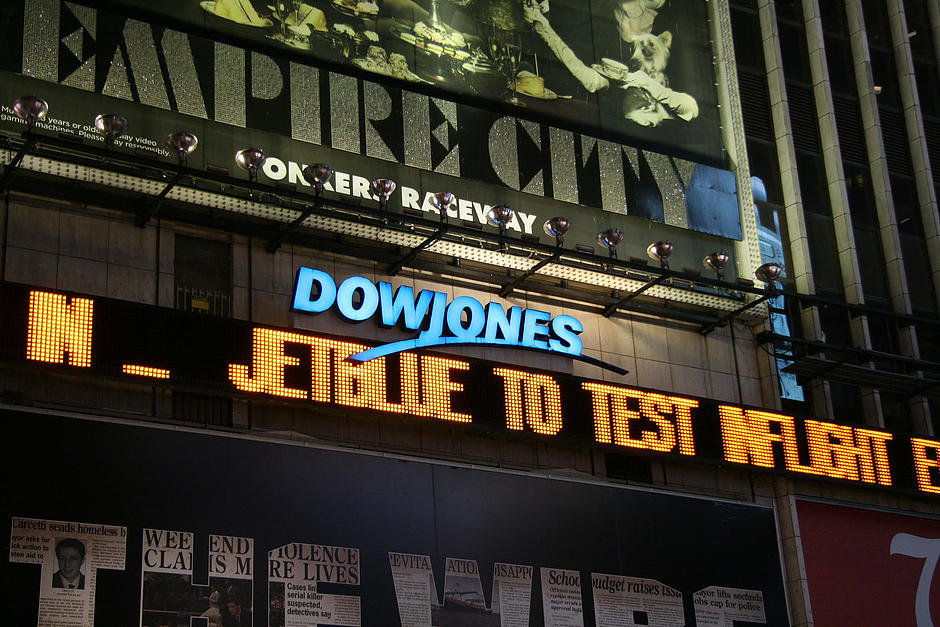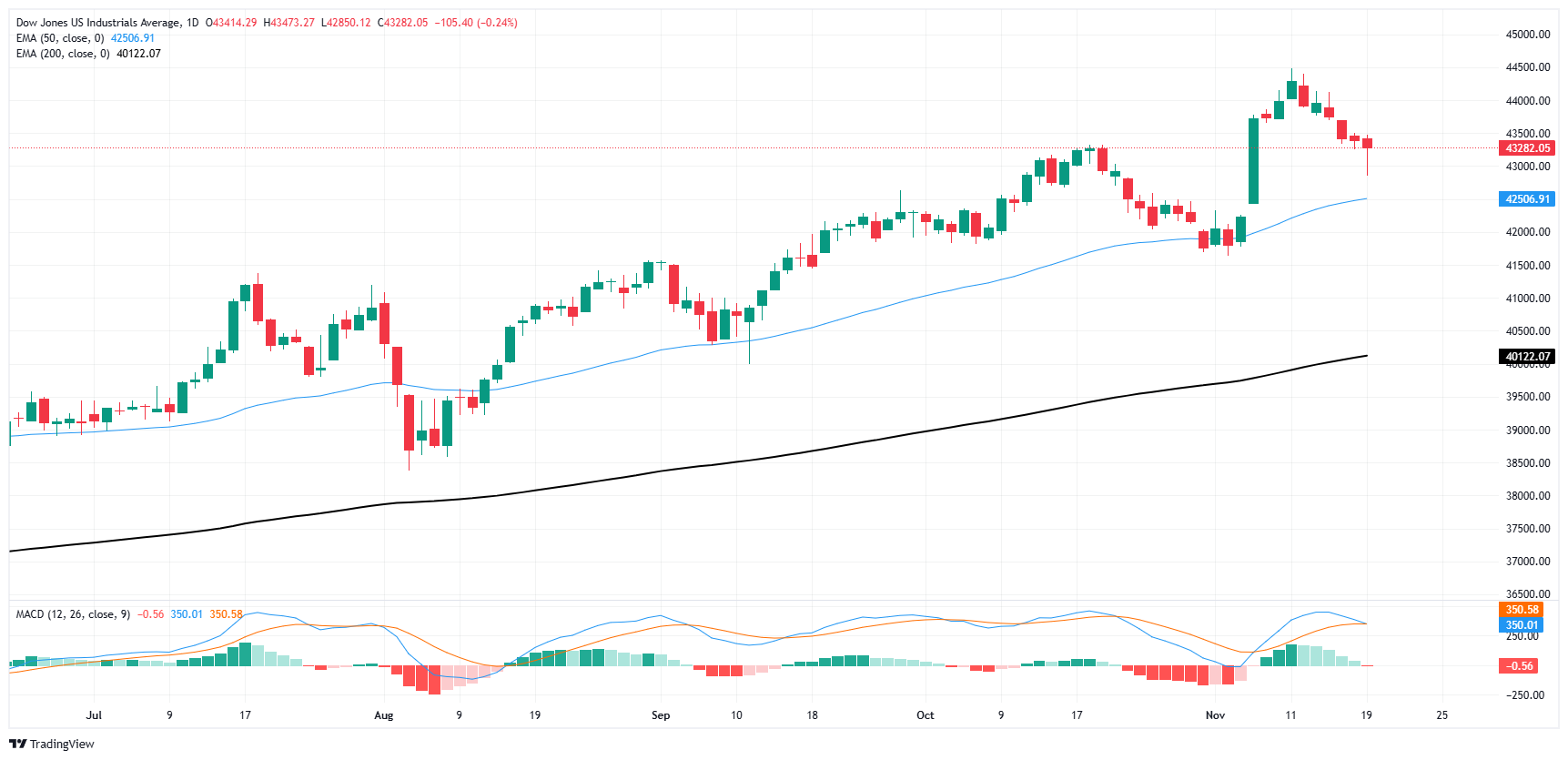Created
: 2024.11.20













![]() 2024.11.20 04:30
2024.11.20 04:30
The Dow Jones Industrial Average (DJIA) took a knee early Tuesday, backsliding to 42,850 during the early US market session after Russia lowered its threshold for nuclear weapon use after Ukraine deployed US-provided weapons within Russia's borders. Equity market broadly recovered their stance for the day, however the Dow Jones remains hobbled, stuck near the day's opening bids.
Russian President Vladimir Putin warned global markets that Russia's self-imposed threshold for the use of nuclear weapons has been lowered after Ukraine forces deployed US-provided weapons within Russia's borders as the small European country continues to fight back against Russia's invasion. Brandishing nuclear weapons spooked investors, sparking a brief risk-off bid before flows normalized once again. Russia's planned three-day invasion of Ukraine that began late February of 2022 is about to enter its thousandth day.
US economic data releases remain thin in the front half of the trading week. Mid-tier Initial Jobless Claims are due on Thursday, and expected to show a slight uptick in the number of new unemployment benefits seekers for the week ended November 15. US S&P Purchasing Managers Index (PMI) activity figures will be the number to watch this week, but won't be dropping on investors until Friday.
A broad-market recovery in equities following geopolitical jitters didn't quite penetrate the Dow Jones fully. A little under half of the major index's listed securities are in the green for Tuesday, but most meaningful gains are contained within a few key companies. Walmart (WMT) jumped 4% to $87.50 per share after reporting a better-than-expected third-quarter performance and raising its annual earnings outlook. Nvidia (NVDA) also rose 3.8% to $145.50 per share ahead of its earnings call after market close on Wednesday; investors expect the chipmaker's recent pivot further into AI-focused GPU chips known as Blackwell to help hoist the silicon stamping company to $33 billion in 3Q revenue, an 83% increase YoY.
The Dow Jones explored further downside on Tuesday, dipping to an intraday low of 42,850 before recovering back into the day's opening range just north of 43,200. The major equity index is poised to close lower for a fourth straight trading day as stocks continue to cool off from the post-election frenzy that sent bids into fresh record highs.
Dow Jones price action is still trading on the high side of the 50-day Exponential Moving Average (EMA) near 42,500, and it's down to a coin toss on whether bearish momentum will continue to drag prices even lower or if bulls will gather their feet and send the DJIA into fresh highs above 44,400.

The Dow Jones Industrial Average, one of the oldest stock market indices in the world, is compiled of the 30 most traded stocks in the US. The index is price-weighted rather than weighted by capitalization. It is calculated by summing the prices of the constituent stocks and dividing them by a factor, currently 0.152. The index was founded by Charles Dow, who also founded the Wall Street Journal. In later years it has been criticized for not being broadly representative enough because it only tracks 30 conglomerates, unlike broader indices such as the S&P 500.
Many different factors drive the Dow Jones Industrial Average (DJIA). The aggregate performance of the component companies revealed in quarterly company earnings reports is the main one. US and global macroeconomic data also contributes as it impacts on investor sentiment. The level of interest rates, set by the Federal Reserve (Fed), also influences the DJIA as it affects the cost of credit, on which many corporations are heavily reliant. Therefore, inflation can be a major driver as well as other metrics which impact the Fed decisions.
Dow Theory is a method for identifying the primary trend of the stock market developed by Charles Dow. A key step is to compare the direction of the Dow Jones Industrial Average (DJIA) and the Dow Jones Transportation Average (DJTA) and only follow trends where both are moving in the same direction. Volume is a confirmatory criteria. The theory uses elements of peak and trough analysis. Dow's theory posits three trend phases: accumulation, when smart money starts buying or selling; public participation, when the wider public joins in; and distribution, when the smart money exits.
There are a number of ways to trade the DJIA. One is to use ETFs which allow investors to trade the DJIA as a single security, rather than having to buy shares in all 30 constituent companies. A leading example is the SPDR Dow Jones Industrial Average ETF (DIA). DJIA futures contracts enable traders to speculate on the future value of the index and Options provide the right, but not the obligation, to buy or sell the index at a predetermined price in the future. Mutual funds enable investors to buy a share of a diversified portfolio of DJIA stocks thus providing exposure to the overall index.
![]()
Created
: 2024.11.20
![]()
Last updated
: 2024.11.20

FXStreet is a forex information website, delivering market analysis and news articles 24/7.
It features a number of articles contributed by well-known analysts, in addition to the ones by its editorial team.
Founded in 2000 by Francesc Riverola, a Spanish economist, it has grown to become a world-renowned information website.
We hope you find this article useful. Any comments or suggestions will be greatly appreciated.
We are also looking for writers with extensive experience in forex and crypto to join us.
please contact us at [email protected].
Disclaimer:
All information and content provided on this website is provided for informational purposes only and is not intended to solicit any investment. Although all efforts are made in order to ensure that the information is correct, no guarantee is provided for the accuracy of any content on this website. Any decision made shall be the responsibility of the investor and Myforex does not take any responsibility whatsoever regarding the use of any information provided herein.
The content provided on this website belongs to Myforex and, where stated, the relevant licensors. All rights are reserved by Myforex and the relevant licensors, and no content of this website, whether in full or in part, shall be copied or displayed elsewhere without the explicit written permission of the relevant copyright holder. If you wish to use any part of the content provided on this website, please ensure that you contact Myforex.
Myforex uses cookies to improve the convenience and functionality of this website. This website may include cookies not only by us but also by third parties (advertisers, log analysts, etc.) for the purpose of tracking the activities of users. Cookie policy